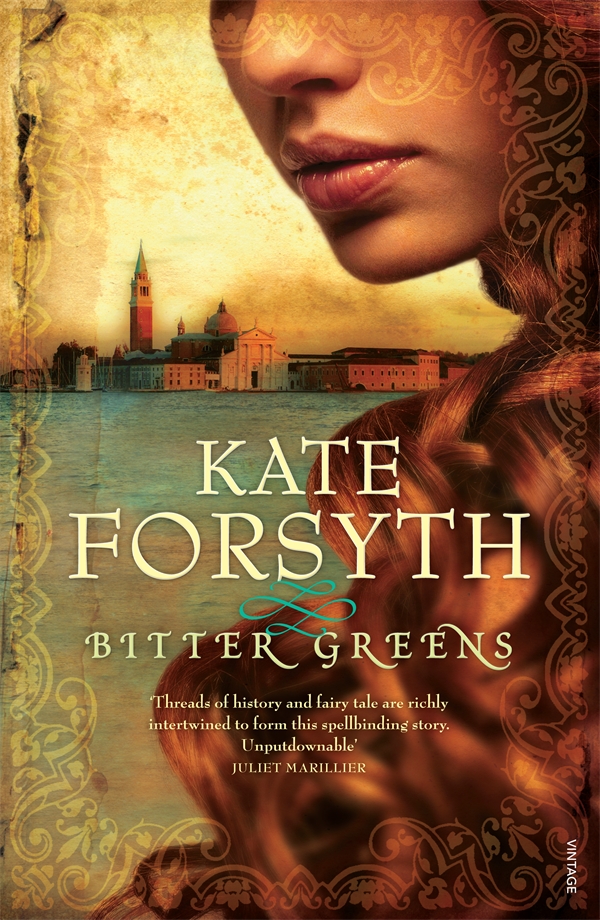Recuperating from pretty awful surgery has given me the chance to indulge in my absolute favourite past-time: reading. I read a great deal anyhow, particularly when researching my novels and for my newspaper columns, but for sheer joy doesn’t happen often enough. One of the upsides of being unwell is that it’s given me an excuse. Over the next few days, I will try and post reviews of some of the wonderful novels I have immersed myself in, starting with Kate Forsyth’s magnificent work, Bitter Greens.
 I confess I’m a long time fan of Kate Forsyth’s work ever since I read the The Witches of Eileanan and sent my first email ever to an author to express my appreciation. I know the high standards Kate sets and that which her readers have come to expect and what a marvellous storyteller she is, even so, this did not prepare me for the experience of reading Bitter Greens. Quite simply, this is an outstanding, mesmerizing book that is one of the finest works of historical fiction I have read.
I confess I’m a long time fan of Kate Forsyth’s work ever since I read the The Witches of Eileanan and sent my first email ever to an author to express my appreciation. I know the high standards Kate sets and that which her readers have come to expect and what a marvellous storyteller she is, even so, this did not prepare me for the experience of reading Bitter Greens. Quite simply, this is an outstanding, mesmerizing book that is one of the finest works of historical fiction I have read.
Weaving the tale of the infamous French writer, Charlotte-Rose de la Force with the tale of Rapunzel, Forsyth delivers a luscious, sensual and incredibly moving tale of love, betrayal, politics, religion, female friendship, desire and gender against the backdrop of Renaissance France and the court of the Sun-King Loius XIV and the heady life of a courtesan in Sixteenth Century Venice.
Moving from Charlotte-Rose’s story to the apparently fictitious one of Rapunzel, known in this book by two different names, and yet again to another major female character (in at least Rapunzel or Margherita’s tale), the bella strega (beautiful witch) and courtesan, Selena Leonelli, the reader is admitted into three what seem at first very different female lives, cultures and times. Only, as their stories develop and unfold, the similarities far outweigh the differences. From imprisonment created by sex and gender roles, to that enforced by faith and parental rules, to the laws laid down by king and country, it becomes evident that Rapunzel’s tower is not worst kind of entrapment a women can endure. Cleverly using the tower as a metaphor for the different ties that cruelly and gently bind, as well as the redemptive power of story-telling, Forsyth has crafted a beautiful and powerful story of three strong women that lingers in the imagination long after you put it down.
Written as the creative part of a current Doctorate, it’s clear that Forsyth has done her research. Anyone who has plunged into the history of fairytales understands that it was the Brothers’ Grimm whom we have to thank and curse for many of the current and highly sanitized versions of centuries old and told folk tales that frequent contem porary culture – Grimm and Disney. Forsyth has eschewed these and returned to earlier and darker source material and in doing so, given the novel a veracity and depth that is simply breathtaking. The detail of French court life, of the nunnery, and the way she brings Venice of that time to life is deftly done, never detracting from the plot of character development. In the acknowledgments you read about the translations Forsyth commissioned and the trips she took as research for her novel. They were well worth it and as someone who has both researched and taught the history and signifance of fairytales and myths at university, I would love to read her thesis when it’s complete.
porary culture – Grimm and Disney. Forsyth has eschewed these and returned to earlier and darker source material and in doing so, given the novel a veracity and depth that is simply breathtaking. The detail of French court life, of the nunnery, and the way she brings Venice of that time to life is deftly done, never detracting from the plot of character development. In the acknowledgments you read about the translations Forsyth commissioned and the trips she took as research for her novel. They were well worth it and as someone who has both researched and taught the history and signifance of fairytales and myths at university, I would love to read her thesis when it’s complete.
Overall, I thought this a simply amazing book that once again left me in awe of this woman’s formidable talent and grateful that she (and I!) live in times where women can write their tabulations and share them. A tour de force indeed!
